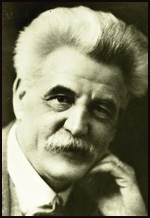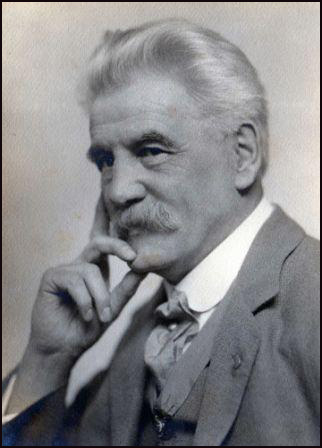Barry Parker

Richard Barry Parker, the eldest son of Robert Parker, a bank manager, and his wife, Frances Booth, was born at Chesterfield, Derbyshire, on 18th November 1867. He was educated at Wesley College in Sheffield before attending South Kensington School of Art in London.
In 1889 Parker was articled to G. Faulkner Armitage, an architect based in Altrincham, Cheshire. He eventually established his own practice in Buxton. One of his first projects was to design three houses for his father, including the family home Moorlands.
In 1893 Parker's elder sister Ethel Parker married her half-cousin Raymond Unwin. Barry Parker initially disapproved of the marriage as he was an opponent of Unwin's socialist beliefs. Unwin was a member of the Socialist League, an organisation founded by William Morris. and was closely associated with radicals such as Edward Carpenter, Walter Crane, Eleanor Marx, Ernest Belfort Bax, Edward Aveling, John Bruce Glasier and Ford Madox Ford. Carpenter described Unwin during this period as "a young man of cultured antecedents… healthy, democratic, vegetarian".
Barry Parker rejected Unwin's politics but was influenced by his brother-in-law's ideas on architecture. In 1894 Parker collaborated with Unwin to design a church for the mining community of Barrow Hill. According to Andrew Saint: "Unwin devised the strategy and layout and Parker the aesthetic detail; and such, as a rule, was to be the division of labour in their later working relationship. There followed the formal architectural partnership of Parker and Unwin, run between the brothers-in-law on an easy and amicable basis... Housing was always the focus: initially the internal planning of the middle-class home or artisan's house, then the grouping of small houses, and finally complete suburban and civic layouts, as Unwin's mastery of all sides of ‘the housing question’ grew. The partners' early practice consisted largely of arts and crafts homes for progressive businessmen, furnished with ample living-rooms and inglenooks... such designs alternate with picturesque, communal groups of working-class cottages round an open green, with plans offering bigger living-rooms at the expense of the outmoded front parlour."
Parker's biographer, Mervyn Miller, points out: "Parker's commissions included individual middle-class houses, often complete with fittings and furniture. Unwin brought his engineering and costing skills to the practice, but wished to design working-class housing: Parker assisted with the visualization of this ideal, designing ‘an artisan's living room’ and a housing quadrangle (unbuilt) for a Bradford site.... The influence of C. F. A. Voysey and M. H. Baillie Scott was evident in Parker's houses.... These works showed progressive simplification of form, growing confidence of spatial design, and integration of furniture into a total ensemble."
On 10th June 1899, Ebenezer Howard and his friends established the Garden City Association. The Association organised lectures on "garden cities as a solution of the housing problem" which were addressed "to educational, social, political, co-operative, municipal, religious and temperance societies and institutions". Members included Raymond Unwin, Edward Grey, William Lever, Edward Cadbury, Ralph Neville, Barry Parker, Thomas Howell Idris and Aneurin Williams.
In 1900 the Garden City Limited was established with share capital of £50,000. The following year a conference was held at Bournville which three hundred delegates attended. Unwin gave a talk at the conference and this led to Joseph Rowntree commissioning him and Parker to design houses for his workers in New Earswick. As John Moss-Eccardt pointed out: "Both young men wanted to express their convictions, which were greatly influenced by Ruskin and Morris, in visual architecture... This was an important part of the social reform movement, more than a mere alleviation of poor housing and environmental conditions in industrial towns. It ranked as a forerunner of garden cities in that it paid attention deliberately to creating an environment which promoted health and happiness in its inhabitants."
In 1903 the Garden City Association had over 2,500 members. The Garden City Pioneer Company was constituted, with Ebenezer Howard as managing director, to find a suitable site for the first garden city. In 1903 Howard purchased 3,818 acres in Letchworth for £155,587. Howard employed Parker and Raymond Unwin as the architects responsible for building Letchworth Garden City.
Unwin explained: "The successful setting out of such a work as a new city will only be accomplished by the frank acceptance of the natural conditions of the site; and, humbly bowing to these, by the fearless following out of some definite and orderly design based on them ... such natural features should be taken as the keynote of the composition; but beyond this there must be no meandering in a false imitation of so-called natural lines."
Parker also held strong views on creating a beautiful environment. He believed that the destruction of a single tree should be avoided, unless absolutely necessary. It was decided that it was important to make full "use of the undulating nature of the terrain to provide vistas and prospects. By grouping numbers of houses together it was possible to have large gaps between the groups, thus providing views of gardens, countryside or buildings beyond."
Andrew Saint has argued: "The concept of the self-sufficient garden city promoted by Howard in Garden Cities of Tomorrow (1898–1902) having been entirely diagrammatic, Unwin was in effect asked to endow Letchworth with an image and identity. This raised issues of industrial and civic planning, phasing, and investment on a scale that no British architect had hitherto faced. The plan was revised in 1905–6, when work at Letchworth commenced. The housing areas got the earliest attention, Unwin tackling road layout, grouping, plot size, style, and supervision with originality and a remarkable perception of the complex issues. But Letchworth's civic centre, which was allotted an axial approach perhaps derived from Wren's plan for rebuilding London, grew too slowly for the ideas of Parker and Unwin to be carried through, and remains a grave disappointment. Despite Unwin's critical role at Letchworth, where he lived between 1904 and 1906, he never identified wholly with Howard's obsession with autonomous garden cities on virgin sites detached from metropolitan influence, and indeed left further work at Letchworth to Parker after 1914."
Parker and Unwin were also involved in the building of the Hampstead Garden Suburb. The main sponsor was Henrietta Barnett, wife of Unwin's early mentor Samuel Barnett. Parker and Unwin designed "short rows of houses with deep gardens, culs-de-sac, open courts, advanced and recessed frontage lines, boundary hedges, a varied geometry of open spaces, ‘vista-stoppers’ for sight-lines, and skewed road junctions". According to Henrietta's biographer, Seth Koven: "She embarked on her last and most ambitious project, which dominated the final decades of her life: rescuing 80 acres of Hampstead Heath for public enjoyment and creating the Hampstead Garden Suburb.... Collaborating with the pioneer socialist architects of the Letchworth Garden City, Raymond Unwin and Barry Parker, she created a blueprint for a new kind of organic community consisting of young and old, able-bodied and infirm, rich and poor, married and unmarried. While the largest homes of wealthy residents were placed far from the modest cottages designed for artisans Henrietta hoped that residents of the suburb would be bound together by shared religious, social, educational, and recreational spaces. To this end she successfully advocated the erection of an Anglican church and a nonconformist chapel, along with a purpose-built clubhouse for artisans and their families; the institute, designed by Edwin Lutyens, served as the suburb's focal point for educational, cultural, and civic activity. Henrietta balanced her unwavering commitment to the mutual advantages of relationships between the classes with a staunch belief in the ineradicability of class differences."

In 1914 Raymond Unwin dissolved his partnership with Barry Parker and started work as chief town planning inspector to the Local Government Board. During the First World War he was seconded as chief housing architect to the wartime Ministry of Munitions. This marked the start of Unwin's alliance with Christopher Addison, who at that time was minister of munitions. In July 1917 Unwin joined Addison when he became minister of reconstruction.
Barry Parker now pursued an independent career. According to his biographer, Mervyn Miller: "In 1915 he spent six months in Porto, Portugal, redesigning the civic centre, and from 1917 to 1919 he worked in São Paulo, Brazil, on the Jardim America Garden suburb. In 1919 he took the consultancy for New Earswick, and designed its inter-war housing. Council housing schemes for Newark, Nottinghamshire, St Neots, Huntingdonshire, Bridport, Dorset, and Loughborough, Leicestershire, were followed by a planning consultancy for Wythenshawe, the garden satellite of Manchester (1927–41). Influenced by American practice, its innovative master plan incorporated parkways and defined neighbourhood units, which Parker had seen in New York in 1925. Although building was not begun until Wythenshawe was brought within the Manchester city boundary, by 1934 its population of 25,000 was greater than Letchworth and Welwyn Garden City combined."
Barry Parker died on 21st February 1947.
Primary Sources
(1) John Moss-Eccardt, Ebenezer Howard (1973)
The leader of any new enterprise must choose his collaborators wisely if success is to be achieved. Howard did this in his choice of planners, Barry Parker and Raymond Unwin, who found in Letchworth a great opportunity to put into practice the ideas that had been forming in their minds for some time previously. They too had a great interest in the social problems caused by unrestrained urbanisation but their philosophies were based on backgrounds in which the liberal arts were strongly represented.
